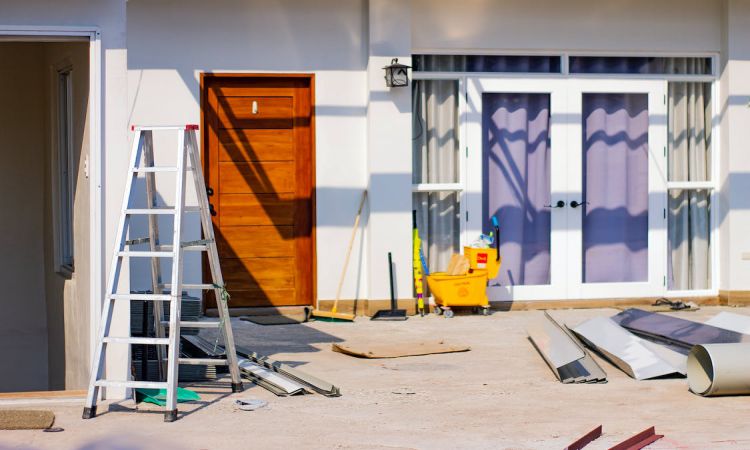 Remodeling the house can be an exciting plan for homeowners and yet a stressful struggle at the same time. Depending on your remodeling goals, it is better to devise a plan and consider each household member’s needs. It is also essential to consider what will boost the value of your property and what materials will ensure longevity.
Remodeling the house can be an exciting plan for homeowners and yet a stressful struggle at the same time. Depending on your remodeling goals, it is better to devise a plan and consider each household member’s needs. It is also essential to consider what will boost the value of your property and what materials will ensure longevity.
If you plan to remodel your entire house, it is best to consider the exterior and address specific concerns. Is your home architecturally appealing from the outside? Or is the paint peeling with visible cement and brick residue? Alternatively, it could just be dirty and requires deep cleaning. After fixing the exterior walls and roof, think about the interior. Any remodeling project should target places that need significant changes to the structural layout or additions to the house.
Whether you hire professionals or do the remodeling yourself, you will need a plan, material information, and proper time management to ensure adequate implementation. The following tips should help you get your remodeling project off the ground with minimal hassle.
1. Make use of Storage Units
Storage units are great for removing all the furniture and household items before renovating or remodeling the house. If you live in Lincoln, for instance, you will find excellent options in Lincoln NE self storage units, offering a variety of sizes.
Storage units are a great solution if you want to declutter or move all items in storage for home renovation. If you own a small 2-bedroom house, you can book a 10’x10′ storage unit to keep all your household items. Similarly, if you need to declutter, then a 5’x10′ storage unit will work for you.
Storage units offer several amenities, including cold storage and temperature control systems, 24-hour surveillance, digital locks, parking, and easy booking and payment procedures.
2. Know Your Remodeling Goal
Before doing anything, you must first determine what you are trying to achieve. Are you remodeling to enhance the real estate value of your home? Or are you bored with the old designs and want to bring in some new elements? Do you need a new entryway or have enough space to add a new section? Or, do you want to increase your car’s parking area or build a shed? Consider the current condition of your home and the surrounding area before investing in major changes.
Once you know what you need, you can proceed with the planning stage.
3. Make a Thorough Plan
Planning includes deciding whether to hire home renovators or to do it yourself. When redesigning a bedroom, consider the opinions of the person who uses the room. You need to determine the materials you would require and the designs.
For example, kids may need a study table and a bunk bed with décor featuring their favorite things. If they like to read at night, maybe you could plan to install a spotlight and a bookshelf alongside their bed. Alternatively, add a playhouse with lights and a toybox for the playroom.
Consider the parts of the house that might need a little added protection and support, fixing a few holes on the roof, or adding vinyl column wraps to your outdoor posts. Since you’re already doing construction in the house, you might as well add it.
Similarly, consider your storage needs when remodeling your bedroom and decide on a theme. Many homeowners prefer installing full-length floor-to-ceiling bedroom cabinets or a separate walk-in closet to save space in their bedrooms.
Planning is essential no matter what your remodeling goal is.
4. Budgeting
Before buying supplies or hiring an interior designer, establish your budget. Either way, you have to have a budget to see how much you can spend on the remodeling, how intensive it can be, or how far you can stretch it.
It is best to set your priorities, so you know where to allocate your budget and how it can best fulfill your needs. In addition, have a contingency fund and a backup plan. Getting your entire kitchen renovated may lead to the cost of eating out or staying in a hotel for a couple of days. Make sure that you cater to such unforeseen costs within your budget.
However, regarding cost, do not compromise on the quality of paint, fixtures, fittings, and construction material. It can lead to added costs when the paint comes off, or the wall fixtures fall off, and you need to pay for repairs.
5. Consult an Architect
Remodeling your entire home may require the insights of a professional. Perhaps they could suggest better solutions considering their experience and expertise level. An architect will also be able to provide you with cost estimates of elements like new tiles for the bathroom with varying qualities.
They can sketch out a plan based on your requirements and make your home look better. They could identify extra spaces where you can build your pantry, extend the laundry room, or perhaps build a small supplies closet.
If you have the budget, hiring a professional would be ideal. The company will get the team on board with your project, gather all the relevant supplies, and do all the heavy lifting. In addition, their consultation fee is nominal compared to hiring them for a full-fledged project. All you need to do is communicate your needs, decide on the designs, and give them your budget. They will take care of the rest.
6. Focus on Space and Minimalist Styles
Space is important, especially if you have a large family or your kids are young. The more open and spacious your kitchen, dining area, and sitting area are, the more appealing and manageable they will be. Members typically spend most of their time in these three spaces.
Extending your living space outdoors can be a great way to bring outdoor spaces into your living space. You can add an extension to your kitchen with sliding doors if your kitchen is tiny. It will give the illusion of a large kitchen. Perhaps add a seating area in the backyard with colorful lights to spend your evenings in.
Make your home feel like a family home where anyone feels welcome.
Conclusion
When remodeling your home, always plan and establish your budget to avoid inconvenience. Use self-storage facilities to declutter and remove the furniture before tearing down any walls or rooftops since the debris can ruin your belongings.
Have a remodeling goal and plan accordingly. Consult an architect for aesthetic insights and design inspiration. Hire one if you can, and focus on creating light and spacious rooms to add a welcoming charm, especially if your house is small. Add a section to enlarge your living space and invest in an attractive façade and landscaping to improve curb appeal and real estate value. Think in terms of effective storage options to declutter your home.
Make use of these points when planning to renovate or remodel your home. These tips will help you plan your home renovation project more efficiently.




